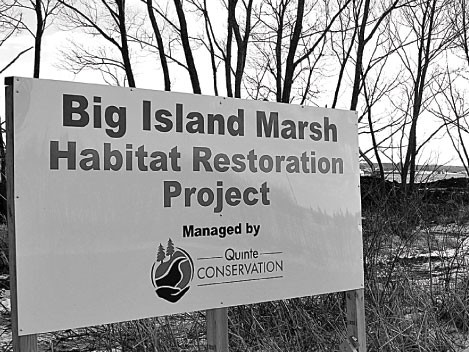County News
Plugged shut

Work under way to restore Big Island wetland
The water was so shallow across the marshy channel it was likely inevitable that our forefathers would one day construct a causeway linking Big Island to the County mainland. Unforeseen, or more likely unconsidered, in the march toward progress was the effect the causeway—effectively a long dam—would have on the large wetland behind it.
Along the way Lake Ontario was tamed for shipping purposes further compromising the wetland. No longer was the marsh subjected to periodic flooding and dry periods. Things have been pretty regular and predictable around the marsh for the past 60 years.
So much so that the wetland has been transformed from a wildly diverse habitat for a wide variety of species of plant, fish and animals to the exclusive domain of cattails and not much else.
Water once flowed freely through a series of winding channels penetrating the marsh—but without the natural flushing occurring and with a roadway shoring up one side, the waterways have largely closed in.
Two years ago a dragline carved a two-metre channel through the length of the marsh but this has since largely been reclaimed by the cattails. Another approach was needed.
The Big Island marsh is not the only wetland struggling to manage the unintended consequences of human progress.
In 1992 and 1998 a restoration project was conducted on the Sawguin Creek Marsh in western Ontario. There they dug a network of channels down to a depth of about nine metres.
It appears to have worked. Twenty years later the channels have remained mostly intact and now support numerous fish and wildlife species—including species at risk.
Work has begun on an equally elaborate restoration project on the Big Island marsh according to Terry Murphy, general manager of Quinte Conservation.
Using private funds, Quinte Conservation has embarked on a project to connect existing channels to a series of new interconnected waterways, ponds and channels to, in effect, ventilate the marsh. In this way it is anticipated that increased waterflow will help ensure the channels remain intact.
Work is already under way carving out a large pond in phase one. If the full funding for the project is approved, Murphy estimates a total project cost of about $5 million, to be completed before the end of the year.


Comments (0)